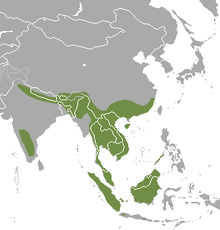Small-clawed otter
| Asian small-clawed otter | |
|---|---|
 |
|
| Scientific classification | |
| Kingdom: | Animalia |
| Phylum: | Chordata |
| Class: | Mammalia |
| Order: | Carnivora |
| Family: | Mustelidae |
| Subfamily: | Lutrinae |
| Genus: |
Amblonyx Rafinesque, 1832 |
| Species: | A. cinerea |
| Binomial name | |
|
Amblonyx cinerea (Illiger, 1815) |
|
 |
|
| Oriental small-clawed otter range | |
| Synonyms | |
|
Amblonyx cinereus |
|
Amblonyx cinereus
Aonyx cinereus
Aonyx cinerea
The Asian small-clawed otter (Aonyx cinerea syn. Amblonyx cinereus), also known as the oriental small-clawed otter or simply small-clawed otter, is a semiaquatic mammal native to South and Southeast Asia. It is a member of the otter subfamily (Lutrinae) of the weasel family (Mustelidae), and is the smallest otter species in the world. Its paws are a distinctive feature; its claws do not extend beyond the fleshy end pads of its partially webbed fingers and toes. This gives it a high degree of manual dexterity so that it can use its paws to feed on molluscs, crabs and other small aquatic animals.
The Asian small-clawed otter inhabits mangrove swamps and freshwater wetlands in South and Southeast Asia. It lives in extended family groups with only the alpha pair breeding; offspring from previous years help to raise the young. Due to ongoing habitat loss, pollution, and hunting in some areas, it is listed as Vulnerable on the IUCN Red List.
This species was originally described as the only member of the genus Amblonyx, but was transferred to the genus Aonyx after analysis. However, further studies have shown that this species is more closely related to the genus Lutrogale than to Aonyx, which means the genus Amblonyx should be retained. A synonym for the Asian small-clawed otter is Aonyx cinereus.
...
Wikipedia

